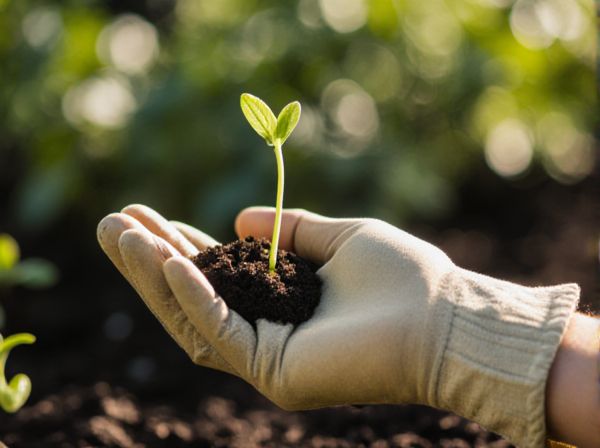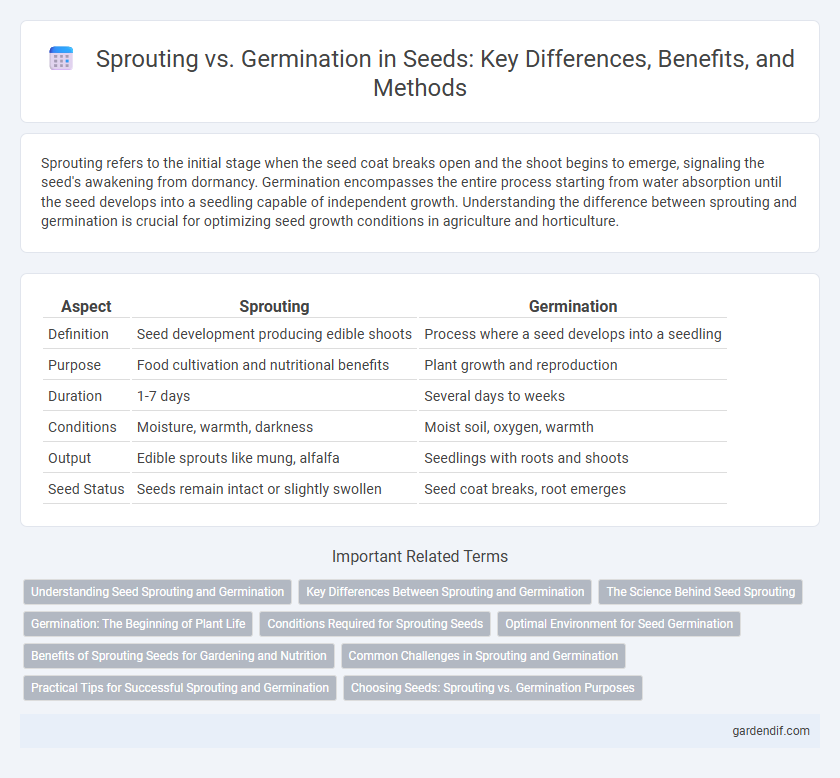
Sprouting vs Germination Illustration
Sprouting refers to the initial stage when the seed coat breaks open and the shoot begins to emerge, signaling the seed's awakening from dormancy. Germination encompasses the entire process starting from water absorption until the seed develops into a seedling capable of independent growth. Understanding the difference between sprouting and germination is crucial for optimizing seed growth conditions in agriculture and horticulture.
Table of Comparison
| Aspect | Sprouting | Germination |
|---|---|---|
| Definition | Seed development producing edible shoots | Process where a seed develops into a seedling |
| Purpose | Food cultivation and nutritional benefits | Plant growth and reproduction |
| Duration | 1-7 days | Several days to weeks |
| Conditions | Moisture, warmth, darkness | Moist soil, oxygen, warmth |
| Output | Edible sprouts like mung, alfalfa | Seedlings with roots and shoots |
| Seed Status | Seeds remain intact or slightly swollen | Seed coat breaks, root emerges |
Understanding Seed Sprouting and Germination
Seed sprouting marks the initial phase when a seed absorbs water and begins to swell, signaling the start of growth, while germination encompasses the entire process from this initial activation to the emergence of a seedling. Understanding seed sprouting involves recognizing water uptake (imbibition) and cellular activation, whereas germination includes radicle emergence and seed coat rupture. Factors such as temperature, oxygen availability, and moisture critically influence both sprouting and germination efficiency in various seed types.
Key Differences Between Sprouting and Germination
Sprouting refers specifically to the initial growth phase when a seed begins to grow shoots and roots, typically observable within a few days under moist conditions. Germination encompasses the entire process from seed imbibition to the emergence of the seedling, including cellular activation and metabolic changes. Key differences include the scope, with germination covering biochemical changes inside the seed, while sprouting focuses on visible growth stages.
The Science Behind Seed Sprouting
Seed sprouting involves complex biochemical processes where water uptake triggers enzymatic activity, breaking down stored food reserves to fuel embryo growth. Germination marks the initial phase where the radicle emerges, signaling the seed's transition from dormancy to active development. Understanding hormone regulation, particularly gibberellins and abscisic acid, reveals how environmental factors control seed sprouting and successful plant establishment.
Germination: The Beginning of Plant Life
Germination marks the initial stage of plant life when a seed absorbs water, activates enzymes, and begins cellular growth, leading to the emergence of a seedling. Key factors influencing germination include temperature, moisture, oxygen, and seed viability. Understanding germination is essential for optimizing crop yield and successful plant propagation.
Conditions Required for Sprouting Seeds
Sprouting seeds require optimal moisture levels, temperatures between 65-75degF (18-24degC), and adequate oxygen for successful growth initiation. Light conditions vary by seed type but generally, indirect sunlight or darkness promotes sprouting, preventing energy loss. Maintaining consistent humidity and avoiding waterlogging ensures seeds remain hydrated without rotting, vital for healthy sprout development.
Optimal Environment for Seed Germination
Seed germination requires a consistent temperature range typically between 20-30degC (68-86degF) and adequate moisture to trigger enzymatic activity for seedling growth. Well-aerated soil with proper oxygen levels supports root respiration, while avoiding waterlogged conditions prevents seed rot. Light exposure varies by species, with some seeds needing darkness for germination and others requiring light to break dormancy, emphasizing the importance of adjusting environmental factors for optimal seed sprouting.
Benefits of Sprouting Seeds for Gardening and Nutrition
Sprouting seeds accelerates seedling growth by breaking down complex nutrients into simpler forms, enhancing nutrient bioavailability and boosting vitamins like B and C. This process improves germination rates by promoting healthy root development and increasing resistance to soil-borne diseases, supporting stronger, more vigorous plants. Nutritionally, sprouted seeds offer higher protein digestibility and enriched antioxidant levels, making them a superior choice for both gardening success and dietary benefits.
Common Challenges in Sprouting and Germination
Common challenges in sprouting and germination include inconsistent moisture levels critical for seed activation and root development. Temperature fluctuations can hinder enzymatic processes necessary for successful germination and sprout growth. Contaminants such as mold or bacteria often affect seed viability and sprout quality, requiring careful hygiene and environmental control.
Practical Tips for Successful Sprouting and Germination
Sprouting requires maintaining a warm, dark environment with consistent moisture to encourage rapid growth of shoots, while germination thrives with proper seed-soil contact, temperature control between 65-75degF, and adequate light exposure. Use clean, sterilized containers and rinse sprouts twice daily to prevent mold during sprouting; for germination, ensure well-draining soil and avoid overwatering to promote strong root development. Selecting high-quality, viable seeds and monitoring humidity around 70% improves success rates for both sprouting and germination processes.
Choosing Seeds: Sprouting vs. Germination Purposes
Choosing seeds for sprouting differs from selecting seeds for germination purposes due to variations in seed size, hardness, and nutrient content. Sprouting seeds, such as alfalfa or mung beans, require high germination rates and non-toxic seed coatings for safe consumption, while germination seeds prioritize optimal soil conditions and seed vigor for plant growth. Understanding these differences ensures selection aligns with desired outcomes, whether for edible sprouts or robust seedlings.
Sprouting vs Germination Infographic

 gardendif.com
gardendif.com